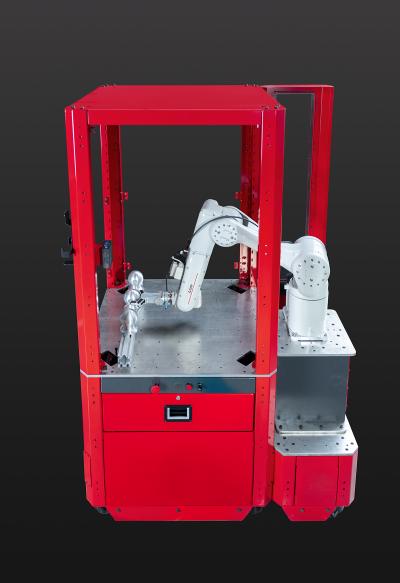
Mitsubishi Electric Automation, Inc. is announcing the release of its LoadMate Plus engineered solution. LoadMate Plus is a robot cell which can be easily moved for efficient use, and is targeted towards manufac- turers in CNC machine tool applications that find themselves facing a la- bor crunch, while needing to be more efficient and improve their production.
The robot cell provides flexible solutions for traditionally high-mix, low-volume facilities to introduce automation, and is designed with mobility and flexibility in mind. LoadMate Plus automates the task of loading and removing parts from a machine tool through the use of robotics, and can be mounted next to one machine, between two mach- ines, and otherwise moved around a facility as jobs require. When this cell is paired with Mitsubishi Electric M8 Series CNC, operators can use the Direct Robot Control (DRC) feature within the CNC controls to also control and program the robot with menus and G-code from the same screen used for the machine tool. No robot programming experience or teach pendant is required, allowing manufacturers to use existing staff to automate and make adjustments.
"Most automation solutions for machine tending rely on either cobots for flexibility, or industrial robots for performance and larger parts,” said Rob Brodecki, services product manager at Mitsubishi Electric Automation. “With LoadMate Plus, users don’t have to sacrifice one for the other. The cell is flexible, regardless
of the robot, and users can choose from a number of robots to match a shop’s specific needs. Plus, with an available 3-year robot warranty, and Mitsubishi Electric technicians who can service LoadMate Plus, users can ensure that their production will continue uninterrupted.”
LoadMate Plus can be used with a variety of machine tools, including mill, lathe, and drilling/tapping.
Contact Details
Related Glossary Terms
- computer numerical control ( CNC)
computer numerical control ( CNC)
Microprocessor-based controller dedicated to a machine tool that permits the creation or modification of parts. Programmed numerical control activates the machine’s servos and spindle drives and controls the various machining operations. See DNC, direct numerical control; NC, numerical control.
- lathe
lathe
Turning machine capable of sawing, milling, grinding, gear-cutting, drilling, reaming, boring, threading, facing, chamfering, grooving, knurling, spinning, parting, necking, taper-cutting, and cam- and eccentric-cutting, as well as step- and straight-turning. Comes in a variety of forms, ranging from manual to semiautomatic to fully automatic, with major types being engine lathes, turning and contouring lathes, turret lathes and numerical-control lathes. The engine lathe consists of a headstock and spindle, tailstock, bed, carriage (complete with apron) and cross slides. Features include gear- (speed) and feed-selector levers, toolpost, compound rest, lead screw and reversing lead screw, threading dial and rapid-traverse lever. Special lathe types include through-the-spindle, camshaft and crankshaft, brake drum and rotor, spinning and gun-barrel machines. Toolroom and bench lathes are used for precision work; the former for tool-and-die work and similar tasks, the latter for small workpieces (instruments, watches), normally without a power feed. Models are typically designated according to their “swing,” or the largest-diameter workpiece that can be rotated; bed length, or the distance between centers; and horsepower generated. See turning machine.
- milling machine ( mill)
milling machine ( mill)
Runs endmills and arbor-mounted milling cutters. Features include a head with a spindle that drives the cutters; a column, knee and table that provide motion in the three Cartesian axes; and a base that supports the components and houses the cutting-fluid pump and reservoir. The work is mounted on the table and fed into the rotating cutter or endmill to accomplish the milling steps; vertical milling machines also feed endmills into the work by means of a spindle-mounted quill. Models range from small manual machines to big bed-type and duplex mills. All take one of three basic forms: vertical, horizontal or convertible horizontal/vertical. Vertical machines may be knee-type (the table is mounted on a knee that can be elevated) or bed-type (the table is securely supported and only moves horizontally). In general, horizontal machines are bigger and more powerful, while vertical machines are lighter but more versatile and easier to set up and operate.
- robotics
robotics
Discipline involving self-actuating and self-operating devices. Robots frequently imitate human capabilities, including the ability to manipulate physical objects while evaluating and reacting appropriately to various stimuli. See industrial robot; robot.

